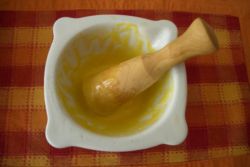This section needs additional citations for verification .(December 2024) |

Valencian cuisine is a Mediterranean cuisine as cooked in the Valencian Community, Spain. Its basic ingredients are vegetables, seafood and meat. It is famous worldwide for its rices, such as paella, and its citrus fruits. The cuisine of neighbouring regions have contributed to and received important contributions from Valencian gastronomy, amongst them Balearic cuisine, Catalan cuisine, Aragonese cuisine, Manchego cuisine and Murcian cuisine.






